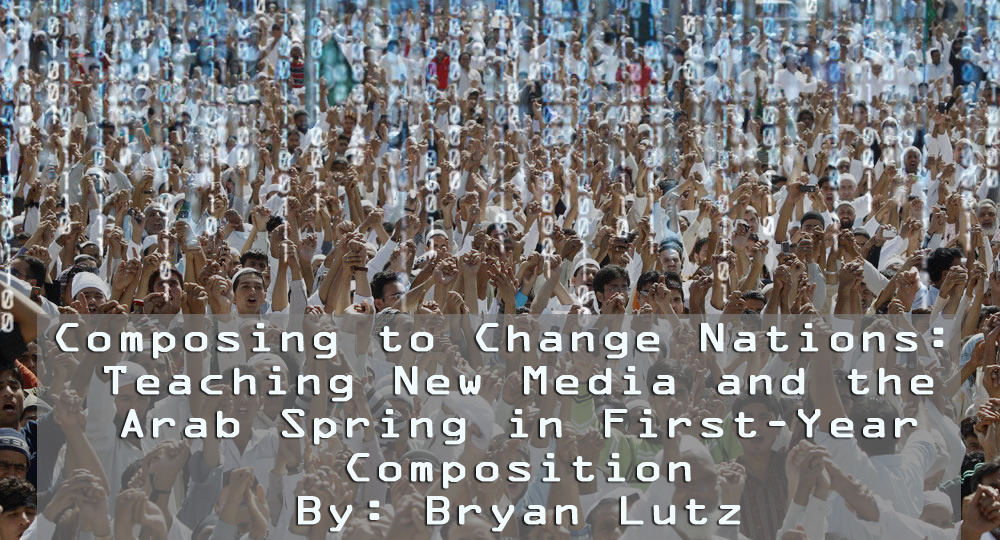Assignment
Goal #4: Civic Engagement
Composing on a blog can be diffcult and time consuming. I usually dedicate five hours of class time a week for two weeks on a quarter system. This time was calculated based upon following calculation. I timed myslef composing my own essay on blogger, and converted my time spent to a word-per-hour ratio: about 160words/hr. Hence my about 10 hours of class time for 1600 word essay, assuming expect to spend some time composing outside of class. Since I have composed my own essay on blogger, I can handle most of students concerns with relative ease. I recommend that an instructor who wants to try this essay in their own class to take the time to compose their own essay and to time themselves at a word-per-hour ratio. This is how I determined the time I would need to give my students to compose.
Furthermore as they compose, there is also more questioning. As part of their peer review process, students must comment on each other’s blog essays to encourage deeper though. Some of these questions can be local revisions, like grammar, punctuation, or even stylistic choices, but most are either encouraging things done well, or requesting clarification on the student’s points. As we are in the computer lab, students can then revisit their sources or search for more to help clarify their points. And since we are using class time to do this, this process acknowledges the fluidity in revision. I can meet with all students at whatever stage they are in and provide help and guidance.
As previously stated, one class is dedicated guiding students through the process of sharing their essays with outside audiences on “Advocacy Day.” On this day class time is dedicated to soliciing responses from the blogs they analyzed before composin. I guide this process by using a drafted message to share their work with their chosen blog authors. As a secondary component, I compiled a list or organizations that may be willing to hear ideas which is product of both my own awareness of different groups, and the contributions of students who find other organizations on their own. In the classroom this manifests itself in ways that are dynamic and highly variable. Some of students prefer to use Facebook and Twitter to share their work with friends and family. Some reported that they did not actively share their own work beyond the audience of other bloggers, but felt proud enough in the work of their peers (and this fact has interesting implications that should be further explored). The most confident students will share their arguments with NGOs, many of which who have responded to their essays with encouragement for the work they are doing (some offered to come speak to the class). I feel that this demonstrates the kind of network building that is implicit in the goals of the assignment. Also, with all the debates over assessment—which tends to either centralizes the teachers as the sole assessor of student work, or centralizes those who make standardized tests that teachers are supposed to teach students to perform well on—the potential for assessment by audiences beyond these teacher-as-examiner is exciting. In short, if first-year writing students assume agency in ways similar to the Arab Spring, then they are engaging each other as agents of invention and persuasive power and engaging audience outside the class as a means to idenitify with their cause. If they are successful in reaching their audiences, then the grade they earn is only part of a much larger network of validations, namely,the experience of participating in a social movement. It is my hope that I can explore the potentials of this more in the future
Finally we return to Ridolfo and Dànielle Nicole DeVoss (2009) and the potential for velocity. The blog allows students to receive instant access to a conversation. Like the Arab Spring, students are participating in conversations concerning social justice as they are happening. The blog also allows students and outside audiences to converse with relative expediency. Thus, students are able to engage the public on issues happening now. If we once again apply the civic voluntarism model, we see that social movements require a unifying identity that encourages people to find solidarity with each other, and that there must be a genuine loss of faith in current authority as well as confidence that a newly established system would be better. By encouraging students to connect with blogs discussing contemporary public issues, students are compsoting as a means to solve contemporary problems by posing possibilities for solutions, all in real time. With velocity there is also the potential that students will become a resource themselves to other bloggers and researchers as once the student’s essays are published, then they are immediately available to anyone on the internet. Though students are not working to overthrow a current authority, like in the Arab Spring, the ways in which they are using the technology is akin to kinds of activity that has already demonstrated nation-changing potential.
